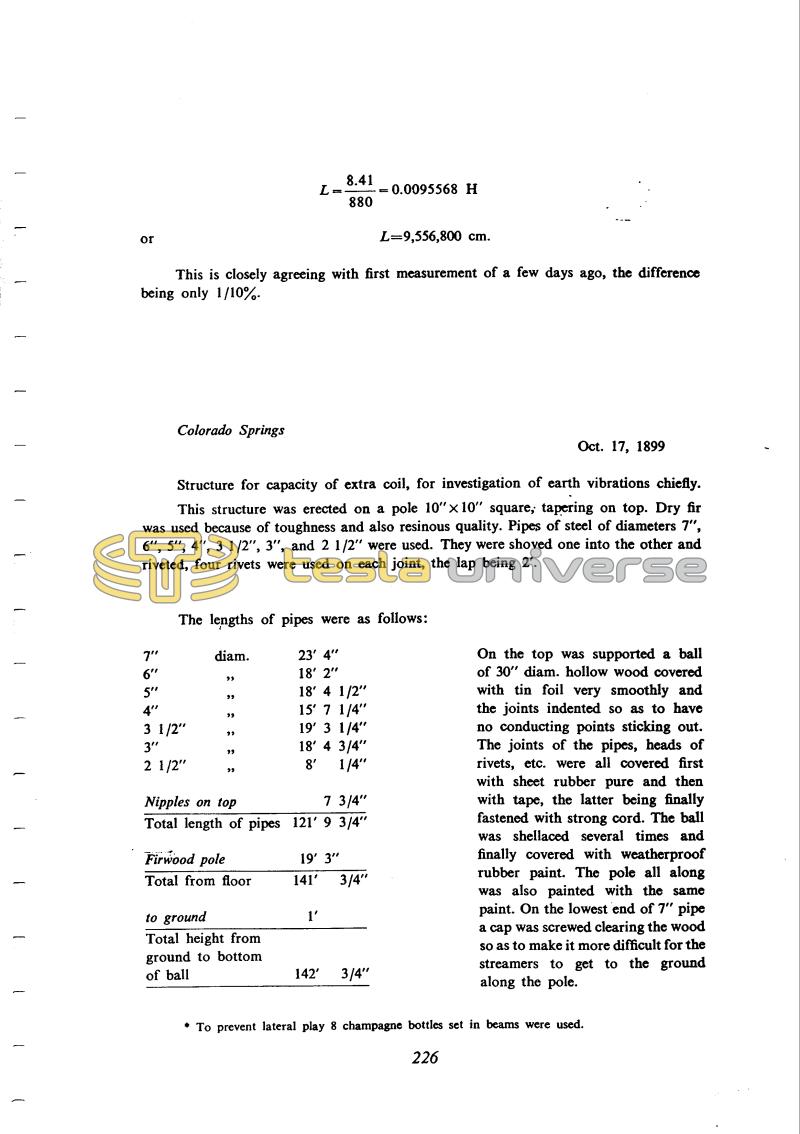
Nikola Tesla Books
!$ {L = {8.41 \over 880} = 0.0095568} !$ H
or
!$ {L = 9,556,800} !$ cm.
This is closely agreeing with first measurement of a few days ago, the difference being only 1/10%.
Colorado Springs
Oct. 17, 1899
Structure for capacity of extra coil, for investigation of earth vibrations chiefly.
This structure was erected on a pole 10" x 10" square, tapering on top. Dry fir was used because of toughness and also resinous quality. Pipes of steel of diameters 7", 6", 5", 4", 3 1/2", 3", and 2 1/2" were used. They were shoved one into the other and riveted, four rivets were used on each joint, the lap being 2'.
The lengths of pipes were as follows:
| 7" | diam. | 23' 4" |
| 6" | " | 18' 2" |
| 5" | " | 18' 4 1/2" |
| 4" | " | 15' 7 1/4" |
| 3 1/2" | " | 19' 3 1/4" |
| 3" | " | 18' 4 3/4" |
| 2 1/2" | " | 8' 1/4" |
| Nipples on top | 7 3/4" | |
| Total length of pipes | 121' 9 3/4" | |
| Firwood pole | 19' 3" | |
| Total from floor | 141' 3/4" | |
| to ground | 1' | |
| Total height from ground to bottom of ball | 142' 3/4" | |
On the top was supported a ball of 30" diam. hollow wood covered with tin foil very smoothly and the joints indented so as to have no conducting points sticking out. The joints of the pipes, heads of rivets, etc. were all covered first with sheet rubber pure and then with tape, the latter being finally fastened with strong cord. The ball was shellaced several times and finally covered with weatherproof rubber paint. The pole all along was also painted with the same paint. On the lowest end of 7" pipe a cap was screwed clearing the wood so as to make it more difficult for the streamers to get to the ground along the pole.
* To prevent lateral play 8 champagne bottles set in beams were used.
226
October 17
The 122 ft metal pole bearing the 30" ball is the antenna to be seen in the middle of the laboratory on many photographs. The bottom end of the antenna is insulated by a wooden pole. This is a single-pole antenna of small electrical length. At around the highest frequencies which Tesla used the h/λ ratio was about 0.015. The terminal capacity made the effective height somewhat greater than h, but it still remained an electrically short antenna.
October 17
He gives a description of a metal pole 43.3 meters in height with a metal globe 67.2 cm in diameter at the top. This is the aerial which could be seen in the middle of the laboratory on the many photographs. The insulator at the bottom of the aerial is a wood-pole stub. The structure is actually a monopole aerial of small electrical length. At the approximate maximum frequencies with which Tesla operated, the ratio H/λ). is approx. 0.015. Due to the terminal capacitance the effective aerial height is somewhat larger than H/2 but even in that case an electrically small aerial is being questioned. The main reason for the construction of this aerial is the testing of the "vibrations in the ground".

